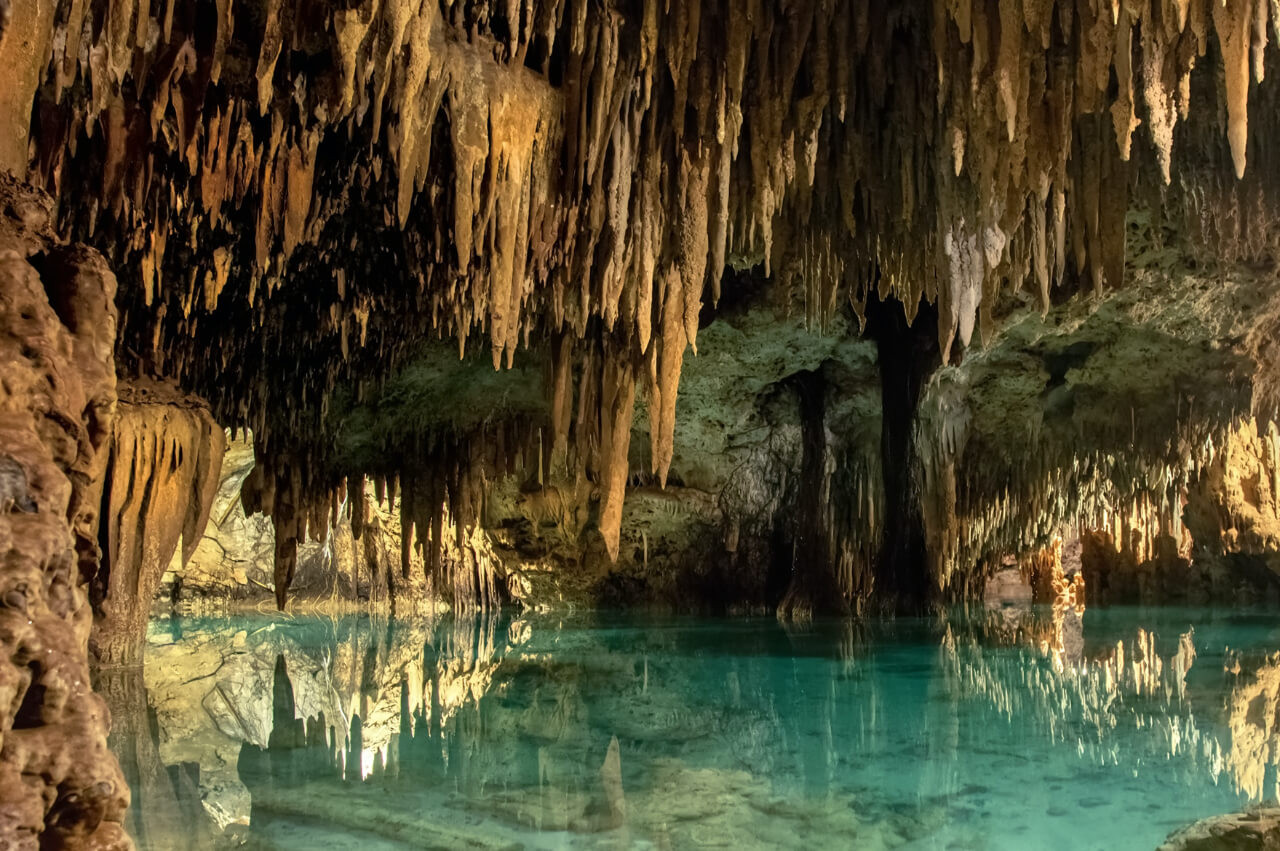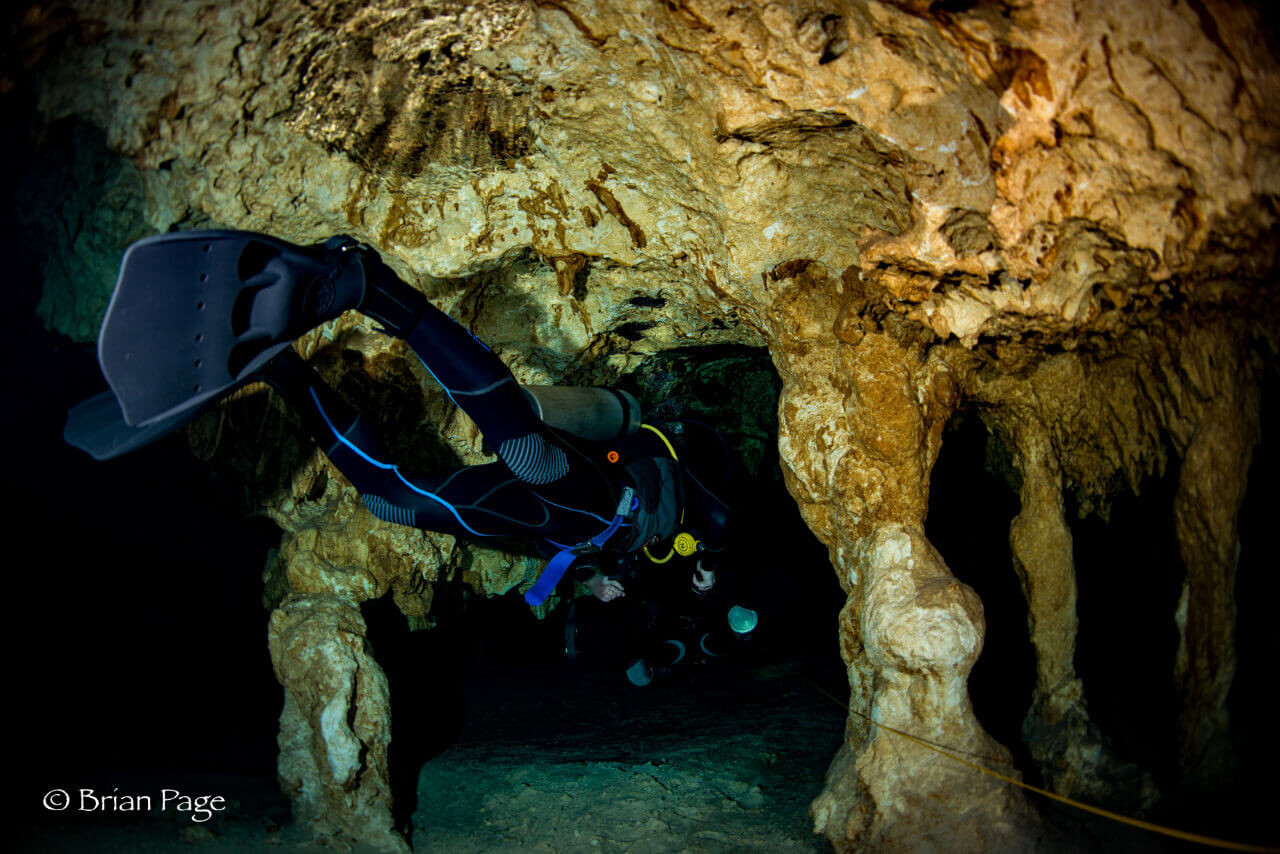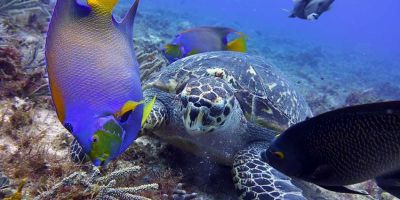Welcome to Blue Experience's ultimate guide to diving in cenotes! As a company based in the Riviera Maya, we know a thing or two about exploring these natural wonders. Cenotes are unique geological formations found throughout the Yucatán Peninsula, and they offer a truly magical and unforgettable adventure. We'll cover everything you need to know about diving in cenotes, from what they are and how they were formed, to the best dive sites along the Riviera Maya and what to expect when you dive. Whether you're a seasoned diver or a beginner, we're here to help you plan the ultimate cenote diving adventure. So, let's dive in!
1. Your first step into the breathtaking world of cenotes
Let's talk about what cenotes are; these magical places are natural sinkholes that were formed when the roof of underground caves collapsed, exposing the groundwater beneath. These unique geological formations are found throughout the Yucatán Peninsula, which includes popular tourist destinations such as Cancún, Playa del Carmen, Akumal, and Tulum.
Cenotes are an integral part of the local Mayan culture, as they were once used as a source of fresh water and considered sacred by the ancient Maya. Today, these natural wells are a popular tourist attraction and a must-see for anyone visiting the Riviera Maya. In addition to their cultural and historical significance, the crystal-clear water and stunning rock formations create an otherworldly atmosphere that is unlike anything you'll experience in open-water diving.

2. Cenote. Cave or Cavern?
Many people use the terms cave and cavern diving interchangeably, but they actually refer to different types of immersion experiences.
-
Cavern diving is defined by the limit that the diver can explore and still see light from the entrance. Although we always carry underwater torches as a requirement, throughout this immersion, our main light source must be the one coming from the entrance – the natural light from the sun. Cavern diving is not a recreational dive, another point to differentiate this immersion from others is that we are never more than 60 m/200 ft from our source of air, and always swim along permanent guideline that ensures to easily find our way back to the surface.
-
Cave diving is the most advanced and challenging form of immersion, as it involves exploring the intricate cave systems that are filled with water. This experience requires specialized training and equipment, and should only be attempted by experienced and specifically trained divers.
At Blue Experience, we offer guided cavern and cave tours for divers of all levels. Our experienced guides will ensure that you have a safe and unforgettable diving experience, no matter what your skill level is!

What certifications do I need?
When venturing into these magical sinkholes in Mexico, an Open Water Diver certification is the minimum requirement. This allows divers to be guided into the cavern zone which is defined as an area within the reach of natural light where it is visible even indirectly, this is no more than 200 linear feet/ 60 mts from the surface.
While guided cavern diving in Mexico, does not demand any other type of special certification, having a minimum of 10 registered dives under your belt is a requirement, with the last one not being more than 12 months ago. We're all about you having the safest and most amazing experience therefore we do recommend doing a couple of dives in the ocean before jumping into cenotes.
It's important to note that venturing into cenotes by yourself, requires specific skills and knowledge that are not covered in a basic Open Water Diver course. To go deeper into cave diving, specialized training, and more extensive diving experience are required, you can start with the Cavern certification which we offer here at Blue Experience Diving Center, followed by Intro to Cave and then dive all your way up to becoming a Full Cave Diver.

3. Exploring cenotes safely
Safety is of utmost importance when it comes to diving in cenotes, these unique systems are definitively beautiful and awe-inspiring, but they also come with their own set of challenges.
There are some important safety rules to keep in mind:
Follow the rule of thirds
The rule of thirds is a fundamental diving safety principle that can be applied to all types of immersions, but is specially observed in cavern, cave and technical diving. Following the rule of thirds divers will use one-third of their air supply for the descent, one-third for the ascent, and keep one-third in reserve. This helps to ensure that divers have enough air to safely complete their dive and handle any unexpected situations that may arise.
Stay within your limits
Cenote diving can be a challenging and technical form of immersion, so it's important to stay within your limits and only attempt dives that are appropriate for your skill level and experience. If you're new to cenote diving or haven't dived in a while, start with an easier dive and gradually work your way up to more challenging ones.
Use the right equipment
Cenote dives in caverns can be performed using your regular diving gear such as wetsuit, fins, mask, regulator, a buoyancy control device (BCD), and underwater torches. It's important to ensure that your equipment is in good condition, fits properly, and is appropriate for the type of diving you're doing.
Dive with a guide
Caves and caverns are complex environments, so in Mexico, it’s mandatory that you dive with a guide who is certified not only as a divemaster or dive instructor, but also as a full cave diver. A guide can help you navigate the underground systems, identify potential hazards, and ensure that you have a safe and enjoyable dive.
Practice good buoyancy control
Buoyancy control is essential for a safe and comfortable experience. Good buoyancy control helps to conserve your air supply. Good buoyancy also will protect the delicate underwater environment by avoiding accidental collisions with the cave floor, walls or formations.

By following these safety rules and guidelines, you can help ensure your cenote dives are safe, enjoyable, and unforgettable. Remember to always prioritize safety, and never take unnecessary risks or push beyond your limits!
4. From Fish to Fossils: What to Expect During Cenote Dives
Exploring the cenotes offers a unique opportunity to witness a diverse range of underwater life that cannot be found anywhere else. The cenotes of the Riviera Maya are home to a variety of fascinating marine life, ranging from colorful fish and crustaceans to unique and rare species that are endemic to the region.
One of the most common things you will see while diving in cenotes are the various types of fish. These include both freshwater and saltwater species, such as catfish, tetra, and tilapias. The clarity of the water in cenotes also allows for excellent visibility of these fish, making them even more enjoyable to watch. Another unique aspect of these magical caves is the chance to witness ancient fossils and rock formations. The cenotes of the Riviera Maya are known for their stunning geological formations, which include stalagmites, stalactites, and columns that have formed over thousands of years. Many of these formations are home to colonies of small crustaceans and other creatures that thrive in the cenote environment.
One of the most unique species you may encounter while inside these cenotes is the Mexican blind brotula. These fish have adapted to the dark and low-light environments of the cenotes by losing their eyes, and instead relying on their other senses to navigate and find food.
It’s important to remember that these creatures are wild and should be respected and observed from a safe distance. Overall, cenote diving in the Akumal, Tulum, and Playa del Carmen areas of the Riviera Maya offers an unparalleled opportunity to witness a diverse range of underwater life and geological wonders. With its crystal-clear water and unique environment, this is truly an unforgettable experience.

5. Investing in Your Diving Experience
If you're new to diving and looking to explore the cenotes, an Open Water Certification course is a good place to start. Here at Blue Experience, we offer PADI Open Water Diver Courses which include all necessary equipment, confined water training, theoretical sessions, and four open water dives. If you want to enjoy more spare time during your holidays, using the PADI e-Learning programmes for the theoretical part of your course is a great option too.
We advise you to check out our guide on how to prepare for your Open Water Diver certification!
For those who already have an Open Water Certification and are looking to advance their diving skills including cenote diving, an Advanced Open Water Certification is a great idea to dive further into these magical waters. Blue Experience Diving offers an Advanced Open Water Course which includes five open water dives in the ocean, or in the cenotes if you decide to include a cavern adventure dive as a part of your Advanced Course.
We also offer different types of experiences for diving into cenotes. For a full day with 2 dives in cenotes between the Playa del Carmen and Tulum area, it's 120 USD. Instead, if you want 2 special dives in the Puerto Morelos area it's 200 USD. It's worth noting that these packages don't come with equipment, but at our center, we take care of having our gear in perfect shape for all your cenote and ocean dives, here you can rent your full diving equipment for 20 USD.
It's important to keep in mind that each cenote has an additional entrance fee. These fees currently range from 15 to 30 USD per person.

6. The cenotes of the Riviera Maya, where to dive?
Different cenotes require different levels of skills, and some may only be accessible to advanced divers. For example, Dos Ojos is a popular cenote that requires divers to have open water certification, it has a maximum depth of 30 feet (10 m) and features beautiful lights coming from above and amazing formations. Other cenotes such as Casa Cenote, the only completely open-air cenote we dive at is suitable for divers of all levels, being the only cenote in which non certified divers can experience Discover Scuba Diving programmes, this cenote has shallow areas with clear water and interesting rock formations, as well as a very interesting cavern passage, making it perfect for divers who are just starting out.
No matter your level of experience, it's important to choose a cenote that is appropriate for your skills and comfort level. At Blue Experience Diving, our experienced guides can help you choose the right cenote for your diving experience, and provide the necessary guidance and support to ensure a safe and enjoyable dive!

In addition to varying levels of difficulty, each cenote also offers a unique underwater environment to explore. From incredible rock formations, and breathtaking light shows. Each dive in a cenote is a new adventure, whether you're an experienced diver or just starting out, cenote diving in the Riviera Maya is an unforgettable experience that should not be missed!


























